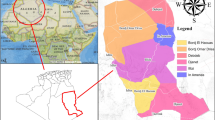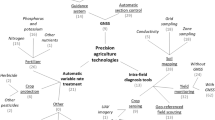Abstract
Rice is generally grown under completely flooded condition and providing food for more than half of the world’s population. Any changes in weather parameters might affect the rice productivity thereby impacting the food security of burgeoning population. So, the crop yield forecasting based on weather parameters will help farmers, policy makers and administrators to manage adversities. The present investigation examines the application of stepwise multiple linear regression (SMLR), artificial neural network (ANN) solely and in combination with principal components analysis (PCA) and penalised regression models (e.g. least absolute shrinkage and selection operator (LASSO) or elastic net (ENET)) for rice yield prediction using long-term weather data. The R2 and root mean square error (RMSE) of the models varied between 0.22–0.98 and 24.02–607.29 kg ha−1, respectively during calibration. During validation with independent dataset, the RMSE and normalised root mean square error (nRMSE) ranged between 21.35–981.89 kg ha−1 and 0.98–36.7%, respectively. For evaluation of multiple models for multiple locations statistically, overall average ranks on the basis of R2 and RMSE of calibration; RMSE and nRMSE of validation were calculated and non-parametric Friedman test was applied to check the significant difference among the models. The ranking of the models revealed that LASSO (2.63) was the best performing model followed by ENET (3.07) while PCA-ANN (4.19) was the worst model which was found significant at p < 0.001. The reason behind good performance of LASSO and ENET is that these models prevent overfitting and reduce model complexity by penalising the magnitude of coefficients. Then, pairwise multiple comparison test was performed which indicated LASSO as the best model which was found similar to SMLR and ENET. So, for prediction of rice yield, these models can very well be utilised for west coast of India.




Similar content being viewed by others
References
Akinbile CO, Akinlade GM, Abolude AT (2015) Trend analysis in climatic variables and impacts on rice yield in Nigeria. J Water Clim Chang 6:534. https://doi.org/10.2166/wcc.2015.044
Annu, Sisodia BVS, Rai VN (2017) An application of principal component analysis for pre- harvest forecast model for wheat crop based on biometrical characters. Int Res J Agric Econ Stat 8:83–87. https://doi.org/10.15740/HAS/IRJAES/8.1/83-87
Azfar M, Sisodia BVS, Rai VN, Devi M (2015) Pre-harvest forecast models for rapeseed & mustard yield using principal component. Mausam 4:761–766
B S Dhekale PKS and TPU (2014) Weather based pre-harvest forecasting of rice at Kolhapur (Maharashtra). Trends Biosci 7:39–41
Balabin RM, Lomakina EI, Safieva RZ (2011) Neural network (ANN) approach to biodiesel analysis: analysis of biodiesel density, kinematic viscosity, methanol and water contents using near infrared (NIR) spectroscopy. Fuel 90:2007–2015. https://doi.org/10.1016/j.fuel.2010.11.038
Basso B, Cammarano D, Carfagna E (2013) Review of crop yield forecasting methods and early warning systems. In: Intergovernmental panel on climate change (ed) climate change 2013 - the physical science basis. Cambridge University Press, Cambridge, pp 1–30
Bhuvaneswari K, Geethalaxmi V, Lakshmanan A et al (2014) Climate change impact assessment and developing adaptation strategies for rice crop in western zone of Tamil Nadu. J Agrometeorol 16:38–43
Bocca FF, Rodrigues LHA (2016) The effect of tuning, feature engineering, and feature selection in data mining applied to rainfed sugarcane yield modelling. Comput Electron Agric 128:67–76. https://doi.org/10.1016/j.compag.2016.08.015
Brejda JJ, Moorman TB, Karlen DL, Dao TH (2000) Identification of regional soil quality factors and indicators I. Central and southern high plains. Soil Sci Soc Am J 64:2115–2124
Cai C, Yin X, He S et al (2016) Responses of wheat and rice to factorial combinations of ambient and elevated CO2 and temperature in FACE experiments. Glob Chang Biol 22:856–874. https://doi.org/10.1111/gcb.13065
Collins LM, Schafer JL, Kam C-M (2001) A comparison of inclusive and restrictive strategies in modern missing data procedures. Psychol Methods 6:330–351. https://doi.org/10.1037/1082-989X.6.4.330
Das B, Sahoo RN, Pargal S et al (2017) Comparison of different uni- and multi-variate techniques for monitoring leaf water status as an indicator of water-deficit stress in wheat through spectroscopy. Biosyst Eng 160:69–83. https://doi.org/10.1016/j.biosystemseng.2017.05.007
Demšar J (2006) Statistical comparisons of classifiers over multiple data sets. J Mach Learn Res 7:1–30
Dhekale BS, Mahdi SS, Dalvi TP, Sawant PK (2014) Forecast models for groundnut using meteorological variables in Kolhapur, Maharashtra. J Agrometeorol 16:238–239
Dutta S, Patel NK, Srivastava SK (2001) District wise yield models of rice in Bihar based on water requirement and meteorological data. J Indian Soc Remote Sens 29:175–181
Friedman J, Hastie T, Tibshirani R (2009) glmnet: Lasso and elastic-net regularized generalized linear models. R Package Version 2009:1
Garcia S, Herrera F (2008) An extension on “statistical comparisons of classifiers over multiple data sets” for all pairwise comparisons. J Mach Learn Res 9:2677–2694
Government of India, Ministry of Agricuture and Farmers Welfare: Deparment of Agriculture Cooperation, and Welfare (2016) India Annu Rep 2016–17
Hastie T, Qian J (2014) Glmnet vignette. http://web.stanford.edu/~hastie/glmnet/glmnet_alpha.html. Last access: 19 June 2018
Jagadish SVK, Murty MVR, Quick WP (2015) Rice responses to rising temperatures - challenges, perspectives and future directions. Plant Cell Environ 38:1686–1698. https://doi.org/10.1111/pce.12430
Jamieson PD, Porter JR, Wilson DR (1991) A test of the computer simulation model ARCWHEAT1 on wheat crops grown in New Zealand. F Crop Res 27:337–350. https://doi.org/10.1016/0378-4290(91)90040-3
Jolliffe IT (1982) A note on the use of principal components in regression. Appl Stat 31:300. https://doi.org/10.2307/2348005
Krishnan P, Ramakrishnan B, Reddy KR, Reddy VR (2011) High-temperature effects on rice growth, yield, and grain quality. Adv Agron 111:87–206
Kuhn M (2008) Building predictive models in R using caret package. J Stat Softw 28:1–26
Kumar N, Pisal RR, Shukla SP, Pandye KK (2014) Regression technique for South Gujarat. MAUSAM 65:361–364
Kumari P, Mishra GC, Srivastava CP (2016) Statistical models for forecasting pigeonpea yield in Varanasi region. J Agrometeorol 18(18):306–310
Lobell DB, Burke MB (2010) On the use of statistical models to predict crop yield responses to climate change. Agric For Meteorol 150:1443–1452. https://doi.org/10.1016/j.agrformet.2010.07.008
Lobell DB, Schlenk er W, Costa-Roberts J (2011) Climate trends and global crop production since 1980. Science 333:616–620. https://doi.org/10.1126/science.1204531
Matsui T, Kobayasi K, Yoshimoto M, Hasegawa T (2007) Stability of rice pollination in the field under hot and dry conditions in the Riverina region of New South Wales, Australia. Plant Prod Sci 10:57–63. https://doi.org/10.1626/pps.10.57
Nishiyama I (1976) Effects of temperature on the vegetative growth of rice plants. Clim Rice 159–185
Nyang’Au WO, Mati BM, Kalamwa K et al (2014) Estimating rice yield under changing weather conditions in Kenya using ceres rice model. Int J Agron 2014:1–12. https://doi.org/10.1155/2014/849496
Oguntunde PG, Lischeid G, Dietrich O (2018) Relationship between rice yield and climate variables in Southwest Nigeria using multiple linear regression and support vector machine analysis. Int J Biometeorol 62:459–469. https://doi.org/10.1007/s00484-017-1454-6
Pandey KK, Rai VN, Sisodia BVS, Singh SK (2015) Effect of weather variables on rice crop in eastern Uttar Pradesh, India. Plant Arch 15:575–579
Piaskowski JL, Brown D, Campbell KG (2016) Near-infrared calibration of soluble stem carbohydrates for predicting drought tolerance in spring wheat. Agron J 108:285–293. https://doi.org/10.2134/agronj2015.0173
Rai YK, Ale BB, Alam J (2012) Impact assessment of climate change on paddy yield: a case study of Nepal agriculture research council (NARC), Tarahara, Nepal. J Inst Eng 8:147–167. https://doi.org/10.3126/jie.v8i3.5941
Rai KK, N P V, Bharti BVS, SA K (2013) Pre -harvest forecast models based on weather variable. Adv Biores 4:118–122
Sánchez B, Rasmussen A, Porter JR (2014) Temperatures and the growth and development of maize and rice: a review. Glob Chang Biol 20:408–417. https://doi.org/10.1111/gcb.12389
Sharma KL, Grace JK, Mandal UK et al (2008) Evaluation of long-term soil management practices using key indicators and soil quality indices in a semi-arid tropical Alfisol. Aust J Soil Res 46:368–377. https://doi.org/10.1071/SR07184
Shi W, Tao F, Zhang Z (2013) A review on statistical models for identifying climate contributions to crop yields. J Geogr Sci 23:567–576. https://doi.org/10.1007/s11442-013-1029-3
Shi W, Yin X, Struik PC et al (2016) Grain yield and quality responses of tropical hybrid rice to high night-time temperature. F Crop Res 190:18–25. https://doi.org/10.1016/j.fcr.2015.10.006
Singh RS, Patel C, Yadav MK, Singh KK (2014) Yield forecasting of rice and wheat crops for eastern Uttar Pradesh. J Agrometeorol 16:199–202
Soares F, Anzanello MJ (2018) Support vector regression coupled with wavelength selection as a robust analytical method. Chemom Intell Lab Syst 172:167–173. https://doi.org/10.1016/j.chemolab.2017.12.007
Sridevi V, Chellamuthu V (2015) Impact of weather on rice—a review. Int J Appl Res 1:825–831
Suleiman A, Tight MR, Quinn AD (2016) Hybrid neural networks and boosted regression tree models for predicting roadside particulate matter. Environ Model Assess 21:731–750. https://doi.org/10.1007/s10666-016-9507-5
Sun W, Huang Y (2011) Global warming over the period 1961-2008 did not increase high-temperature stress but did reduce low-temperature stress in irrigated rice across China. Agric For Meteorol 151:1193–1201. https://doi.org/10.1016/j.agrformet.2011.04.009
Talla A, Swain DK, Tewari VK, Biswal MP (2017) Significance of weather variables during critical growth stages for hybrid rice production in subtropical India. Agron J 109:1891–1899. https://doi.org/10.2134/agronj2017.01.0052
Verma U, Piepho HP, Goyal A et al (2016) Role of climatic variables and crop condition term for mustard yield prediction in Haryana. Int J Agric Stat Sci 12:45–51
Wassmann R, Jagadish SVK, Sumfleth K et al (2009) Regional vulnerability of climate change impacts on Asian rice production and scope for adaptation. Adv Agron 102:91–133
Yang L, Qin Z, Tu L (2015) Responses of rice yields in different rice-cropping systems to climate variables in the middle and lower reaches of the Yangtze River, China. Food Secur 7:951–963. https://doi.org/10.1007/s12571-015-0497-y
Yoshida S (1981) Fundamentals of rice crop science. International Rice Research Institute, Los Banos
Zhang T, Zhu J, Wassmann R (2010) Responses of rice yields to recent climate change in China: an empirical assessment based on long-term observations at different spatial scales (1981–2005). Agric For Meteorol 150:1128–1137. https://doi.org/10.1016/j.agrformet.2010.04.013
Acknowledgements
The India Meteorological Department is duly acknowledged for providing weather data of different stations. This work was supported by the Indian Council of Agricultural Research under Institute project at ICAR-Central Coastal Agricultural Research Institute, Old Goa, Goa, India. The authors are thankful to the reviewer whose comments improved the quality of this paper.
Author information
Authors and Affiliations
Corresponding author
Electronic supplementary material
ESM 1
(DOCX 241 kb)
Rights and permissions
About this article
Cite this article
Das, B., Nair, B., Reddy, V.K. et al. Evaluation of multiple linear, neural network and penalised regression models for prediction of rice yield based on weather parameters for west coast of India. Int J Biometeorol 62, 1809–1822 (2018). https://doi.org/10.1007/s00484-018-1583-6
Received:
Revised:
Accepted:
Published:
Issue Date:
DOI: https://doi.org/10.1007/s00484-018-1583-6




